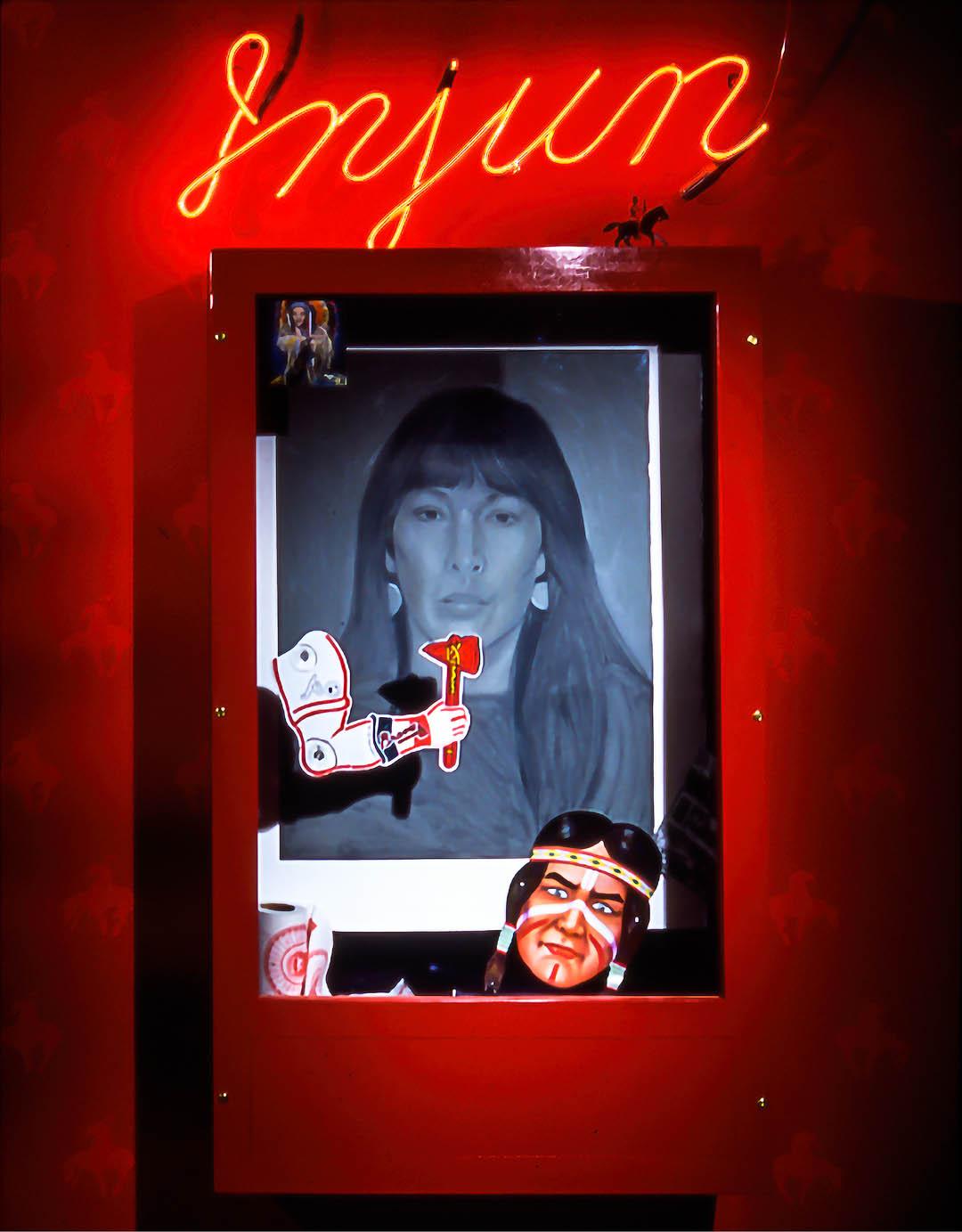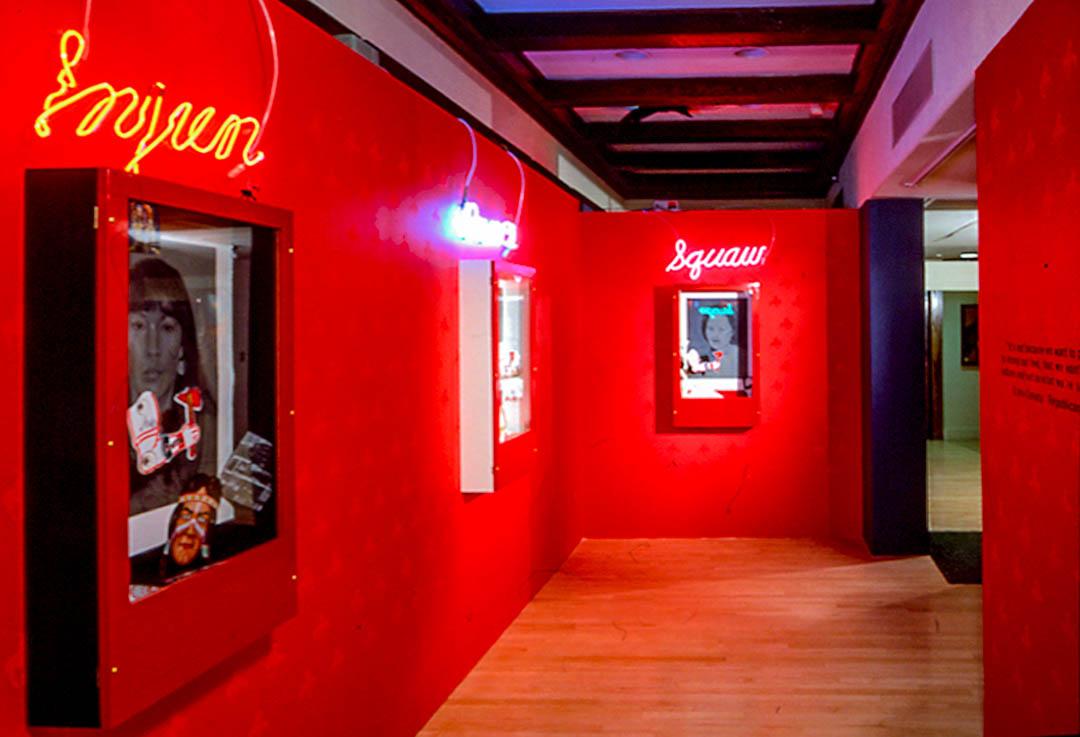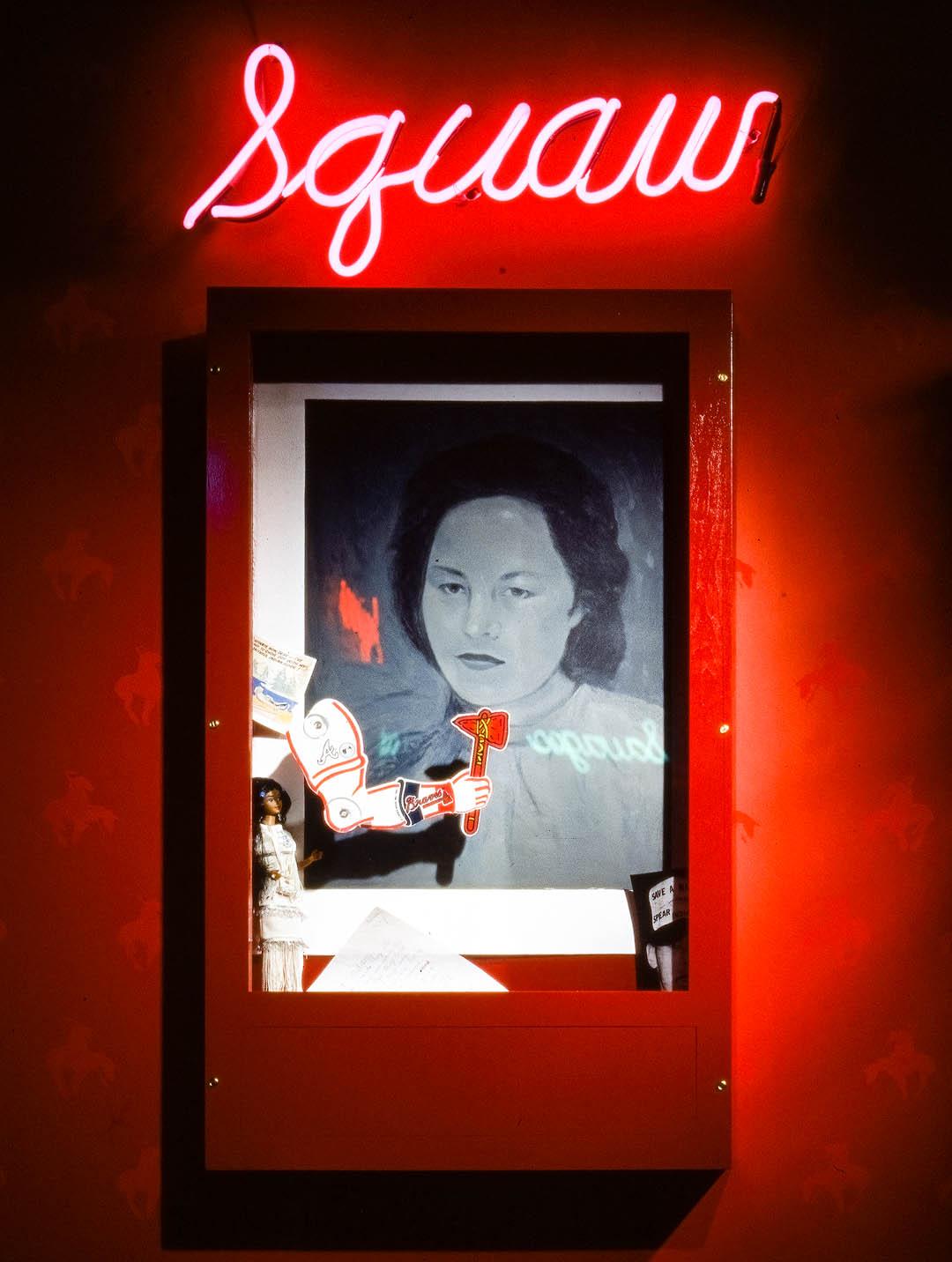It was only an Indian
Environmental installation by artist Charlene Teters lives up to her reputation as a provocative, articulate, and sincere proponent for racial justice, reflecting her personal experience as a frontline political activist, mother, woman, a Spokane, and a human being.
It was only an Indian
IAIA Museum of Contemporary Native Arts (MoCNA) ~ 1994
“I don’t understand what the big deal is. It was only an Indian.” was the Regional Supervisor’s reply when asked to investigate the death of a Jemez Pueblo man who in the line of duty as a U.S. Firefighter. When one is relegated to stereotypes, “It was only” naturally follows.
“It was only an Indian””
Artwinds, Summer 1994
By Don Messec
“I don’t understand what the big deal is. It was only an Indian.” was the Regional Supervisor’s reply when asked to investigate the death of a Jemez Pueblo man who died in 1993 in the line of duty as a U.S. Firefighter.
It was only an Indian, the exhibition, opened amid controversy and acclaim to record attendance at the Institute of American Indian Arts Museum this past Spring. Pre-opening interest in the exhibition peaked with two above-the-fold, front-page banner headlines. Rare for art exhibits.
This most recent environmental installation by artist Charlene Teters lives up to her reputation as a provocative, articulate, and sincere proponent for racial justice. Her work reflects her personal experience as a frontline political activist, mother, woman, a Spokane, and a human being.
Holding a terminal degree in studio arts, Charlene has “made it through the system.” She has made it through a euro descendant Eurocentric education system designed from a cultural foundation different from her own which not coincidentally pushes out more American Indians than any other group.
As a result of this journey and through its concurrent experiences, Charlene has become very familiar with euro-descendant America.
Charlene is fond of asking groups she addresses around the United States, “what do you know about me? How much were you taught in school about my people? I know a lot about you, your fathers, your culture, your faith, your HIStory, but what do you know about the peoples whose land you now occupy?”
The question seems almost innocuous, but its meaning is profound. Its answer makes obvious the roots of misunderstanding, mistrust, invisibility for American Indians, stereotyping, exploitation, denial, injustice, and racism. “It was only in Indian” looks closely at those roots by exposing the pervasive influence of racism evident in the fertile soil of popular culture.
Artists are often defined by their choice of physical medium: oil paint, stone, lithography, photography. Charlene Teters medium is popular culture itself, not simply the objects of popular culture but the intent and content, as well. And she minds popular culture in much the same way discovers, prospectors and energy companies have mined Indian country for 500 years – taking at will – without apology.
In order to accomplish this, Charlene’s work appropriates the entire exhibition space. In “It was only an Indian,” not even the floor escaped her creative process. Even the museum staff found itself struggling with the kind of thought shift so necessary to display installation style work where placement of installation items changes from day to day as the artist fine tunes the work within the gallery.
With Charlene’s approach the creative process continues outside the studio, directly in the gallery. For example, a few days before the exhibition opened, New Mexico senator Billy McKibben was explaining the GOP boycott of the legislature to the press. As if on cue, he said “It’s not that we want to pout, it’s not that we want to stomp our feet, it’s not that we want to act like ugly little Indians and not do what we’re supposed…”
Charlene Teters immediate immortalized the comment by including it in the installation. All of this symbolic activity can be difficult and counter intuitive to people trained to hang a range and view physical compartmentalized ‘Objects D Art’ such as framed paintings and sculpture.
The adjustment to working with an ongoing creation can also be difficult and challenging for artists, many of whom have been miseducated into the mythology of singular maker.
Charlene does not perpetuate the myth that the only definition of artist is as sole maker, alone in the studio with paint and blank canvas. Her art is direct. Her issues are not layered beneath a compulsive process of making. They are not hidden away in the ambiguities of delicate metaphors. Instead, she takes openly from the world around her as she experiences it and layers it as complexly as life itself. Buying and using pre-made items, contracting to have other items made, and making some herself, she alludes to the surroundings of industrial-technological culture in order to disarm the viewer with the familiar.
Having intimate contact with the boot of racial ideology and its concurrent imagery, Charlene’s work goes directly to the source waters of racial indoctrination – popular culture. She takes on popular culture’s perception of what it is to be Indian and then, within these notions, positions what it really is to be indigenous in America.
The juxtaposition of widely held fantasies (Indian = savage; Indian = a turn-of-the-nineteenth-century figure, playing a role in the mythology of Manifest Destiny), with us being subtly presented reality; quietly, but powerfully, unnerves the viewer.
As one travels through It was only an Indian, the pervasive insidious way racism influences popular culture begins to sicken in its own candy-coated sweetness. The viewer becomes aware not only of the way popular culture normalizes racism, but also of its overwhelming presence in everyday life and in its cumulative impact on all people, not just American Indians.
The work itself has entered the struggle to break free from preconceptions. The conflict is reminiscent of Fritz Scholder’s frustration as he tried to break from the precast mold of what Indian art should look like. To this day, he is condemned by those who misunderstood his declaration of freedom, “From this day forward,” he said, “I am no longer an Indian artist!” He was not denouncing his heritage but proclaiming his disassociation from the racism that sought to limit his horizons.
Confusion, invisibility, and dehumanization follow stereotyping. “It was only an Indian” draws a connection between colonialism and white supremacy and continues the connection on through the rise of 19th century Manifest Destiny, turn of the century romanticizing of the “Vanishing American” and right onto modern day mascoting and product identifications. These social elements have had the power to blind non-Indians to the complete humanity of Indian people.
Even more tragic, is the despair it can cause young Indian people caught in a normal crisis of identity that come with developmental periods of passage. “How do my children know their culture is truly valuable and worth continuing if I do not stand to defend it?” Charlene has said in explaining her transition from the more palatable subject matter of her earlier paintings to the arena of overtly political art.
Yet, her work does not scream its messages. Charlene’s environmental installations comfortably seduce the viewer with the familiar and are as sophisticated and rich as is her medium. The work she is doing has grown in strength and presence. Although these works are not ‘objects’ as much art is understood to be, Charlene’s work exhibits a highly refined comprehension of the elements of art.
Even more important, her work exhibits the relationship of art to society and the understanding that there is no such thing as a political art. Collectors ultimately use all art to reinforce some desired sense of identity. The collector can be an individual, a culture, an institution, a religion, or spiritual entity. It does not matter the artwork goes beyond the artist. Because of this relationship, art always expresses some political content.
The political content of most works is usually veiled by the influence of the status quo. But, during times of great political and social upheaval, the political content or distorted political content of art becomes evident. Art is dangerous!
That is certainly how the German Nazi movement saw art that did not reinforce its image of itself as the promoter of family values, a stable society, and German nationalism. In fact, this view led to the gutting of the Bauhaus and arrest and execution of some art artists. Artists were among the earliest occupants of the Nazi concentration camps.
While not as extreme, this belief that art can be dangerous appears to be behind the thinking of senator Jesse Helms and Alfonse D’Amato during the national debate over the National Endowment for the Arts (NEA). The way in which political art is overtly and immediately challenged also punctuates the fact that art is dangerous. The very validity of political art as ‘art’ is question. To what aesthetic foundation does it belong? Who is the proprietor of the presentation? Will interest in the art fade as interest in the political issue it addresses fades?
These challenges are so much greater than those made to so called apolitical art that they create a far higher standard which few artists survive. In fact, it is the rare privilege of only a handful of artists from each generation to be overtly political through their art. Charlene Teters appears to be one of the few this generation will see.
The viewer should be prepared for what is special in her work. Unlike those political artworks whose subjects move quickly from current headline into art, Charlene’s work is grounded and enhanced by the personal nature of each piece.
Her art is her voice alone, founded in her life experience. It speaks for no one else. That her art has found support is the result of it speaking to shared experiences with others, many of whom find her art empowering.
Like all her recent work, “It was only an Indian” is not for sale It exists because there is a need for it, not because there is a market for it.







